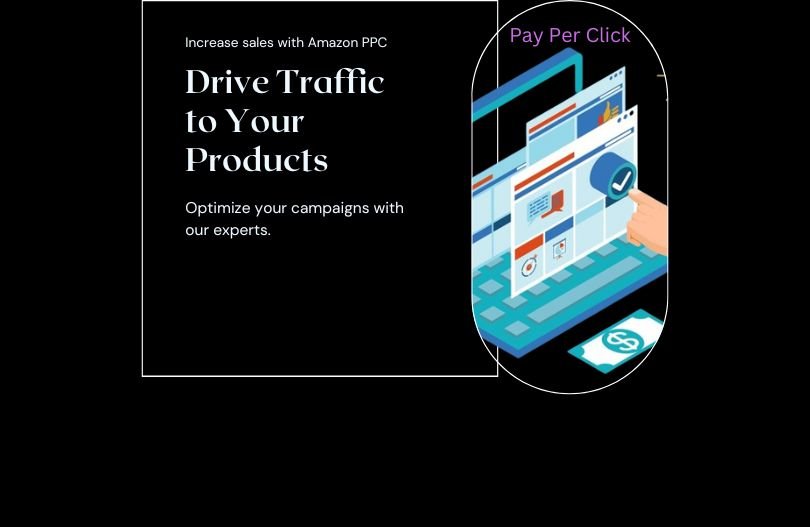

Amazon PPC, or Pay-Per-Click, is an advertising model on Amazon where sellers pay a fee each time a user clicks on their ad. It’s a method sellers use to promote their products and increase their visibility within the Amazon marketplace. Amazon PPC allows advertisers to bid on specific keywords relevant to their products, and when shoppers search for those keywords, the ads appear at the top of search results and on product pages.
Here’s a breakdown of the key components of Amazon PPC:
- Ad Types:
- Sponsored Products: These ads appear in search results and on product detail pages. Sellers bid on keywords, and when a shopper searches for those terms, the sponsored product ad may appear.
- Sponsored Brands: Designed for brand awareness, these ads showcase a brand’s logo, a custom headline, and multiple products. They often appear at the top of search results.
- Sponsored Display: These ads target customers both on and off Amazon, displaying products to shoppers who have viewed similar items or have shown interest in related categories.
- Keyword Bidding:
- Sellers choose relevant keywords for their products and set bids for each keyword. The bid amount represents the maximum amount the seller is willing to pay when a shopper clicks on their ad after searching for that keyword.
- Budgeting:
- Advertisers set a daily or campaign budget to control the overall spending on PPC campaigns. Once the budget is reached, the ads may stop displaying until the next budget cycle.
- Cost-Per-Click (CPC):
- Sellers are charged on a cost-per-click basis, meaning they only pay when a user clicks on their ad. The actual cost per click is determined by the competitive bidding process, with higher bids generally leading to more prominent ad placements.
- Ad Placement:
- Amazon PPC ads can appear in various locations, including search results, product detail pages, and even off Amazon on partner sites. The placement of an ad depends on the type of campaign and bidding strategy.
- Performance Monitoring and Optimization:
- Sellers monitor the performance of their PPC campaigns by analyzing metrics such as click-through rates, conversion rates, and return on ad spend. Optimization involves adjusting bids, adding or removing keywords, and refining ad creatives to improve overall campaign effectiveness.
Top 7 strategies for using Amazon PPC to optimize profits
In the ever-evolving landscape of e-commerce, mastering Amazon’s PPC (Pay-Per-Click) strategies is crucial for maximizing your product’s visibility and profitability. As we step into 2023, staying ahead of the competition requires a strategic approach. In this article, we’ll unveil seven simple yet powerful Amazon PPC strategies that can elevate your business and boost profits.
Keyword Research Excellence:
Begin your Amazon PPC journey with thorough keyword research. Identify relevant, high-volume keywords that align with your product. Leverage tools like Amazon’s own Keyword Tool, as well as third-party tools like Ahrefs or SEMrush, to gain insights into trending keywords and customer search behavior.
Optimize Product Listings for Conversions:
A well-optimized product listing is the foundation of a successful PPC campaign. Ensure your product title, description, and bullet points are compelling and include high-performing keywords. High-quality images and a competitive price also contribute to better conversion rates.
Segment Your Campaigns Effectively:
Divide your PPC campaigns into well-defined ad groups based on product variations or specific keyword themes. This segmentation allows you to customize bids and tailor ad copy, leading to more targeted and efficient campaigns. This precision can positively impact your ad relevance and click-through rates.
Leverage Negative Keywords:
To refine your targeting, utilize negative keywords strategically. By excluding irrelevant search terms, you can prevent your ads from appearing in unrelated searches. This not only helps conserve your budget but also directs your ad spend towards more qualified leads, ultimately boosting your conversion rates.
Optimize Ad Spend with Bid Adjustments:
Make the most of your budget by adjusting bids based on performance. Allocate higher bids to high-converting keywords or peak times, and reduce bids for underperforming ones. Regularly analyze your campaign data to identify trends and make informed bid adjustments that align with your business goals.
Implement Ad Placement Strategies:
Explore different ad placements within the Amazon ecosystem. In addition to the standard sponsored product ads, consider utilizing sponsored brands and sponsored display ads to diversify your reach. Experiment with different placements to discover which ones yield the best results for your specific products.
Regularly Monitor and Adjust Campaigns:
Success in Amazon PPC requires continuous monitoring and optimization. Regularly review your campaign data, track key metrics, and make adjustments as needed. Stay abreast of changes in market trends, competitor activities, and Amazon’s algorithms to adapt your strategies accordingly.
Conclusion:
Increasing your earnings in 2023 requires you to optimize your Amazon PPC campaign. By putting the aforementioned tactics into practice—from employing video ads to establishing strategic bids—you may broaden your audience, improve traffic, and boost revenue.
You may increase ROI and get the most out of each investment dollar with the aid of Amazon PPC. To guarantee success, keep an eye on your advertising expenditures and how they link to click-through rates and sales figures. Then, make any required adjustments.
